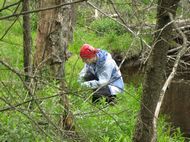You are here
Local Flora Inventory
For nearly a century, Harvard Forest has been the focus of a wide range of  ecological investigations, with a strong emphasis on studies of vegetation, disturbance history, and stand dynamics. Little is known of the local flora prior to the establishment of Harvard Forest in 1907. Hugh Raup developed the first checklist of vascular plants of Petersham, MA, based on his extensive collections in the early 1930s (Raup 1938). Subsequently, C. Earle Smith Jr. (Smith 1948, 1949) summarized what was known of the vascular flora of Petersham, based on the collections of Dr. I. M. Johnson and others in 1947 as well as a review of specimens in the Harvard Forest and New England Botanical Club herbaria.
ecological investigations, with a strong emphasis on studies of vegetation, disturbance history, and stand dynamics. Little is known of the local flora prior to the establishment of Harvard Forest in 1907. Hugh Raup developed the first checklist of vascular plants of Petersham, MA, based on his extensive collections in the early 1930s (Raup 1938). Subsequently, C. Earle Smith Jr. (Smith 1948, 1949) summarized what was known of the vascular flora of Petersham, based on the collections of Dr. I. M. Johnson and others in 1947 as well as a review of specimens in the Harvard Forest and New England Botanical Club herbaria.
Currently, we are conducting field inventories across Harvard Forest properties, recording species lists and noting abundances in broad categories within each compartment in order to map species distributions and general abundances. A review of herbarium records, databases, and relevant literature will enable us to determine which species have previously been found at Harvard Forest and where they were found. Specimen collections or photographic documentation will be made of species that have not previously been documented from Harvard Forest, are uncommon, or are of interest for other reasons. Once complete, this 2-year study of the vascular and bryophyte flora conducted by Harvard Forest Staff and Interns and Jerry Jenkins of the White Creek Field School, will:
- document the current flora of Harvard Forest, including detailed information on the distribution and abundance of locally and regionally uncommon species and invasive species;
- enable a broad evaluation of changes in the flora of Harvard Forest over the past century and a detailed evaluation of changes in the flora over the past 50-60 years by comparing our results with those of Raup (1938) and Smith (1948, 1949);
- serve as a baseline for documenting future changes in the flora.

